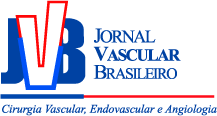Concentração de homocisteína em pacientes portadores de doença arterial periférica atendidos em um serviço público de saúde
Luciene de Souza Venâncio; Roberto Carlos Burini; Winston Bonetti Yoshida
Resumo
Palavras-chave
References
Bhatt DL, Steg PG, Ohman EM. International prevalence, recognition, and treatment of cardiovascular risk factors in outpatients with atherothrombosis. JAMA. 2006;295:180-9.
Selhub J. Homocysteine metabolism. Annu Rev Nutr. 1999;19:217-46.
Boushey CJ, Beresford SA, Omenn GS, Motulsky AG. A quantitative assessment of plasma homocysteine as a risk factor for vascular disease. JAMA. 1995;274:1049-57.
Graham IM, Daly LE, Refsum HM. Plasma homocysteine as a risk factor for vascular disease: The European Concerted Action Project. JAMA. 1997;277:1775-81.
Arnesen E, Refsum HM, Bonaa KH, Ueland PM, Forde OH, Nordrehaug JE. Serum total homocysteine and coronary heart disease. Int J Epidemiol. 1995;24:704-9.
Verhoef P, Hennekens CH, Malinow MR, Kok FJ, Willett WC, Stampfer MJ. A prospective study of plasma homocyst(e)ine and risk of ischemic stroke. Stroke. 1994;25:1924-30.
Boers GH, Smals AG, Trijbels FJ. Heterozygosity for homocystinuria in premature peripheral and cerebral occlusive arterial disease. N Engl J Med. 1985;313:709-15.
Morelli VM, Lourenço DM, DAlmeida V. Hyperhomocysteinemia increases the risk of venous thrombosis independent of the C677T mutation of the methylenetetrahydrofolate reductase gene in selected Brazilian patients. Blood Coagul Fibrinolysis. 2002;13:271-5.
Mölgaard J, Malinow MR, Lassvik C, Holm AC, Upson B, Olsson AG. Hyperhomocyst(e)inaemia: an independent risk factor for intermittent claudication. J Intern Med. 1992;231:273-9.
Malinow MR, Kang SS, Taylor LM. Prevalence of hyperhomocyst(e)inemia in patients with peripheral arterial occlusive disease. Circulation. 1989;79:1180-8.
Brattström L, Israelson B, Norrving B. Impaired homocysteine metabolism in early-onset cerebral and peripheral occlusive arterial disease. Atherosclerosis. 1990;81:51-60.
Selhub J, Jacques PF, Bostom AG. Association between plasma homocysteine concentrations and extracranial carotid-artery stenosis. N Engl J Med. 1995;332:286-91.
Brunelli T, Prisco D, Fedi S. High prevalence of mild hyperhomocysteinemia in patients with abdominal aortic aneurysm. J Vasc Surg. 2000;32:531-6.
Garófolo L, Barros Jr N, Ferreira SR, Sanudo A, Miranda Jr F. Moderate hyperhomocysteinemia in atherosclerotic peripheral arterial disease in the diabetics Nipo-Brazilian population in the city of Bauru. J Vasc Bras. 2003;2(^ssuppl 1):S82.
Miranda Jr F, Garófolo L, Barros Jr N, Ferreira SR, Sanudo A. Influência do gênero na associação entre a hiperhomocisteinemia moderada e arteriopatia periférica em nipo-brasileiros de Bauru. J Vasc Bras. 2003;2:S82.
Kuan YM, Dear AE, Grigg MJ. Homocysteine: an etiological contributor to peripheral vascular arterial disease. ANZ J Surg. 2002;72:668-71.
Nicoloff AD, Taylor LM, Sexton GJ. Relationship between site of initial symptoms and subsequent progression of disease in a prospective study of atherosclerosis progression in patients receiving long-term treatment for symptomatic peripheral arterial disease. J Vasc Surg. 2002;35:38-47.
Taylor LM, De Frang RD, Harris Jr EJ, Porter JM. The association of elevated plasma homocyst(e)ine with progression of symptomatic peripheral arterial disease. J Vasc Surg. 1991;13:128-36.
Taylor LM, Moneta GL, Sexton GJ, Schuff RA, Porter JM. Prospective blinded study of the relationship between plasma homocysteine and progression of symptomatic peripheral arterial disease. J Vasc Surg. 1999;29:8-21.
Ridker PM, Stampfer MJ, Rifai N. Novel risk factors for systemic atherosclerosis: a comparison of C-reactive protein, fibrinogen, homocysteine, lipoprotein(a), and standard cholesterol screening as predictors of peripheral arterial disease. JAMA. 2001;285:2481-5.
Venâncio LS, Burini RC, Yoshida WB. Hiper-homocisteinemia na doença arterial periférica. J Vasc Bras. 2004;3:31-7.
Rutherford RB, Baker JD, Erust C. Recommended standards for reports dealing with lower extremity ischemia: revised version. J Vasc Surg. 1997;26:517-38.
Management of peripheral arterial disease. J Vasc Interv Radiol. 2003;14:S351.
Obesity: preventing and managing the global epidemic. 2003.
IV Diretriz Brasileira sobre Dislipidemia e Prevenção da Atrosclerose. Arq Bras Cardiol. 2007;88(^ssupl 1).
Araki A, Sako Y. Determination of free and total homocysteine in human plasma by high-performance liquid chromatography with fluorescence detection. J Chromatogr. 1987;422:43-52.
Ubbink JB, Vermaak WJ, Bissbort S. Rapid high performance chromatographic assay for total homocysteine levels in human serum. J Chromatogr. 1991;565:441-6.
Ueland PM, Refsum H, Stabler SP, Malinow MR, Andersson A, Allen RH. Total homocysteine in plasma or serum: methods and clinical applications. Clin Chem. 1993;39:1764-79.
Van Den Bosch MA, Bloemenkamp DG, Mali WP. Hyperhomocysteinemia and risk for peripheral arterial occlusive disease in young women. J Vasc Surg. 2003;38:772-8.
Bree A, Verschuren WM, Blom HJ, Nadeau M, Trijbels FJ, Kromhout D. Coronary heart disease mortality, plasma homocysteine, and B-vitamins: a prospective study. Atherosclerosis. 2003;166:369-77.
Rassoul F, Richter V, Janke C. Plasma homocysteine and lipoprotein profile in patients with peripheral arterial occlusive disease. Angiology. 2000;51:189-96.
Taute BM, Taute R, Heins S, Behrmann C, Podhaisky S. Hyperhomocisteinemia: marker of sistemic atherosclerosis in peripheral arterial disease. Int Angiol. 2004;23:35-40.
Baen LS, Zorn WG, van bellen B. Homocysteine in abdominal aortic aneurysm and occlusive disease. An Paul Med Cir. 2003;130:68-70.
Garófolo L, Barros Jr N, Miranda Jr F, DAlmeida V, Cardien LC, Ferreira SR. Association of increased levels of homocysteine and peripheral arterial disease in a Japanese-Brazilian population. Eur J Vasc Endovasc Surg. 2007;34:23-8.
Nygard O, Vollset SE, Refsum H. Total plasma homocysteine and cardiovascular risk profile: The Hordaland homocysteine study. JAMA. 1995;274:1526-33.
Jacques PF, Bostom AG, Wilson PW, Rosenberg IH, Selhub J. Determinants of plasma total homocysteine concentration in the Framingham offspring cohort. Am J Clin Nutr. 2001;73:613-21.
Fukagawa NK, Martin JM, Wurthmann A, Prue AH, Ebenstein D, Orourke B. Sex-related differences in methionine metabolism and plasma homocysteine concentrations. Am J Clin Nutr. 2000;72:22-9.
Elhadd TA, Neary R, Abdu TA. Influence of the hormonal changes during the normal menstrual cycle in healthy young women on soluble adhesion molecules, plasma homocysteine, free radical markers and lipoprotein fractions. Int Angiol. 2003;22:222-8.
Hernanz A. Changes in the intracellular homocysteine and glutathione content associated with aging. Life Sci. 2000;67:1317-24.
Clarke R, Frost C, Leroy V, Collins R. Lowering blood homocysteine with folic acid based supplements: meta-analysis of randomized trials. BMJ. 1998;316:894-8.
Mc Cully KS. Homocysteine, vitamins, and vascular disease prevention. Am J Clin Nutr. 2007;86:1563S-8S.

